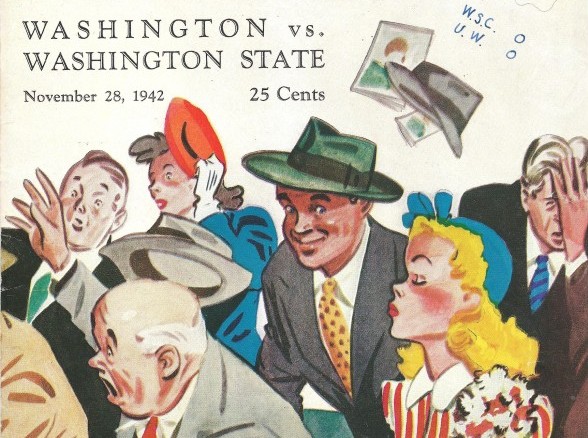
By David Eskenazi and Steve Rudman
It can be argued, without fear of serious debate, that the single greatest individual performance in Apple Cup history, statistically at least, was delivered by Washington’s Hugh McElhenny Nov. 25, 1950.
In front of 28,433 disconsolate Washington State supporters huddled in Spokane’s Joe Albi Stadium, McElhenny sprinted, slogged and generally spreed through the Cougars for 296 yards. His five touchdowns came on on romps of 23, 39, 7, 14 and 84 yards as the Huskies prevailed 52-21.
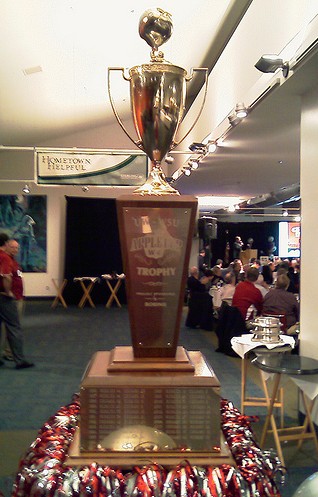
McElhenny averaged an absurd 14.8 yards per carry. His 296 yards remain both Washington and Apple Cup single-game records 62 years later. As it did with McElhenny, then slightly less than a year away from launching a Pro Football Hall of Fame career, the Apple Cup tends to bring out the best in the players.
Washington’s Joe Steele (1976-79) had the best rushing day of his career against the Cougars, a 193-yard effort in 1978. Chris Polk had his best rushing effort, 284 yards, in 2010. Washington State’s Jack Thompson (1975-78) never threw for more touchdowns in a game than the five he pitched against the Huskies in 1976.
The Cougars’ Hugh Campbell, a first-team All-America receiver in 1961, enjoyed the biggest game of his college career against Washington (10 catches, 178 yards) Nov. 24, 1962, the official launch day of the Apple Cup as the official reward. And arguably the best day of Reggie Williams Washington career occurred Nov. 17, 2001, when he snagged 11 balls for 203 yards at the expense of Marcus Trufant and the Cougars.
Flip the calendar back to Nov. 19, 1955. The 4-4-1 Huskies found themselves matched against a 1-6-2 Cougar club in a game that would not have much to recommend it had not Washington’s Credell (Incredible) Green posted the only 200-yard rushing effort of his collegiate career. Green, in fact, gamboled through the deep mud of Husky Stadium for 258 yards and two touchdowns. For good measure, he added an interception.
No crowd at Washingtons football citadel has ever witnessed a better rushing performance in the 48 years that have elapsed since Green earned his moniker. No crowd at Martin Stadium in Pullman ever witnessed one to match the 284-yard Chris Polk avalanche in 2010.
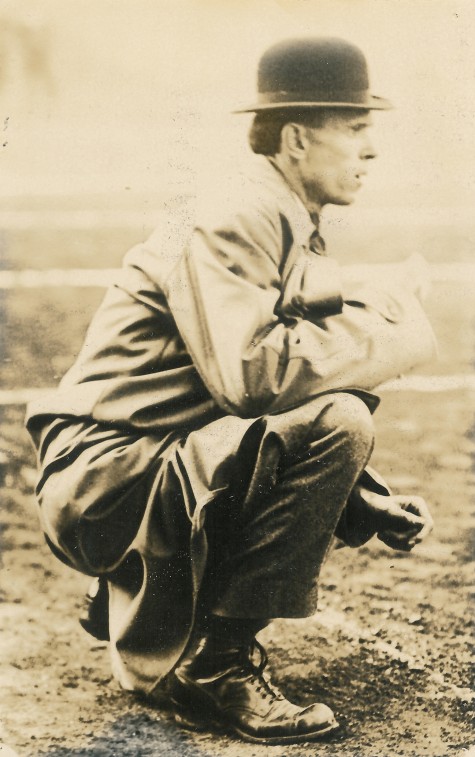
But Apple Cup eminence hasn’t always been about overly gaudy numbers. Fast forward from Nov. 19, 1955 to Nov. 21, 1992, a day when the Palouse blew a billow of snow.
A Rose Bowl-bound Washington team found itself utterly over-matched in what became an Apple Cup classic performance by Washington State quarterback Drew Bledsoe.
Bledsoe threw for 259 yards, not even his best Apple Cup showing in terms of real estate acquired (he delivered 295-yard efforts in 1990 and 1991). But Bledsoe’s uncanny rainbows, making him seem a magician worthy of David Copperfield, proved so compelling that they largely reduced to a footnote the best running performance by a Cougar in Apple Cup history, a 194-yard plow through the snow served up by Shaumbe Wright-Fair on a day when the best Husky runner could not exceed 60 yards.
Attempting to select the all-time best Apple Cup performances is an undertaking made complicated by the evolution of the game, its players and the stakes involved.
Washington’s Don McKeta ran for a meager 67 yards and no touchdowns in 1960, but he did it with a calf that had been split by an errant spike. And his snatch of a pass on a two-point conversion attempt late in the fourth quarter produced an 8-7 Washington victory that sent the Huskies to the 1961 Rose Bowl.
No player in Apple Cup history has been more instrumental in his team winning a single UW-WSU rivalry game than McKeta, unless you consider Hank Grenda of Washington State.
On Nov. 23, 1968, Grenda, starting his first game in a year, scored one touchdown on a quarterback sneak, passed for two others, kicked three extra points, booted a 26-yard field goal and did all of the Cougars punting in a 24-0 WSU victory in Spokane.
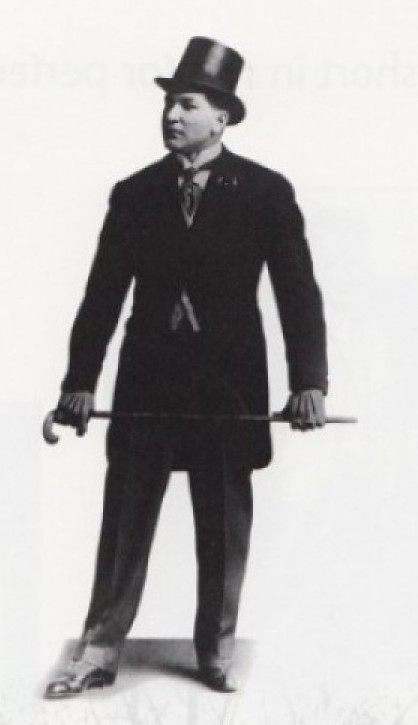
Heading into that contest, the Huskies hadn’t suffered an Apple Cup blanking since 1948. They have not been shut out in an Apple Cup since.
Which might make Hank Grenda’s performance the most remarkable individual effort in Apple Cup history.
Or maybe not. Like all great college football rivalry games, the beauty of the Apple Cup is that there is so much history involved (Teddy Roosevelt sat in the White House when Washington and Washington State first met on a football field) that it’s just as much fun looking back on the series as it is anticipating the next addition.
And since we can’t swallow 100-plus-years of that history whole, well take it in bites to more fully appreciate what we, and those who came before, have witnessed.
APPLE CUP ALUMNI
Pro Champion: Washington’s George Wilson (1923-25) became the first graduate of the UW-WSU series to play on a professional football champion. After leaving UW, Wilson spent one season with the American Football League’s Los Angeles Wildcats and then joined the Providence Steamroller. Wilson was the featured back when Providence won the 1928 NFL title.
The Stock Market Crashed, But . . . : Playing in the 23rd renewal of the UW-WSU series in 1929 were two future NFL Hall of Famers, two future professional head coaches, a future member of the College Football Hall of Fame, a future NFL Most Valuable Player, and the future world record holder in the discus.
Mel Hein and Turk Edwards of WSU entered the Pro Football Hall of Fame in 1963 and 1969, respectively. Hein coached the L.A. Dons of the All-America Football Conference in 1947. Edwards coached the Washington Redskins from 1946-48.
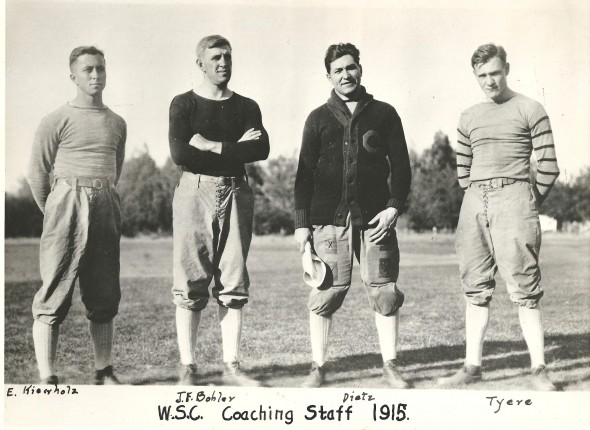
Paul Schwegler of Washington entered the College Football Hall of Fame in 1967. Hein became the NFL’s first-ever MVP in 1938, as a center. Paul Jessup, a tackle for Washington, set a world record in the discus 169-8 7/8 Aug. 23, 1930 at the AAU Track and Field Championships in Pittsburgh.
Future Hall of Famers: From 1930 through 1941, both Washington State and Washington were coached by men who would enter the College Football Hall of Fame.
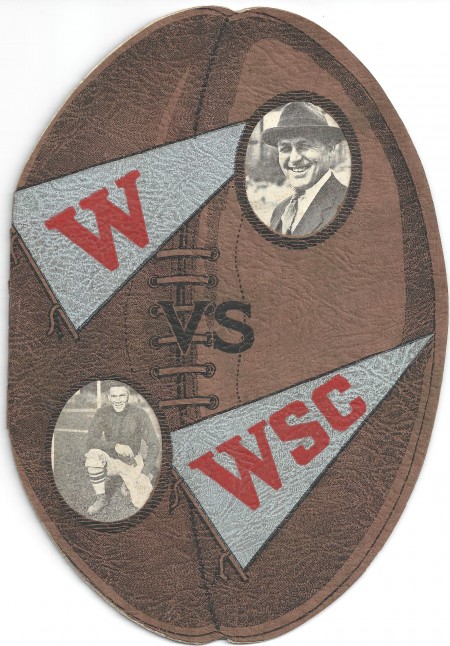
Babe Hollingbery ran the Cougars from 1926-42 and entered the hall in 1979. James Phelan coached the Huskies from 1930-41 and entered the hall in 1973.
First No. 1 Pick: Ed Goddard, a three-time All-America quarterback at WSU (1934-36), became the first Apple Cup alum selected in the first round of the NFL draft. The Brooklyn Dodgers took Goddard in the first round in 1937.
Strangest Injury: Glen Turk Edwards and Mel Hein, Washington State teammates in 1929-30, both went on to play pro football, Edwards with the Boston Braves and Washington Redskins, Hein with the New York Giants.
On Nov. 24, 1940, Edwards and Hein, the respective captains of the Redskins and Giants, met at the center of the field for the pre-game coin toss. When Edwards turned to go back to the Washington bench, his knee collapsed. He never played again.
Last Bows: The 1951 Apple Cup marked the last collegiate contest for a future Pro Bowl MVP (UWs Hugh McElhenny, 1958) and a future Olympic boxing gold medalist, WSUs Pete Rademacher, who won the light-heavyweight world crown in 1956.
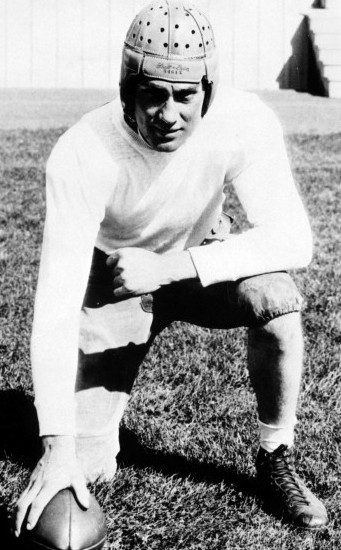
Talent Show: The 1991 Apple Cup, played in Seattle and won by Washington 56-21, featured 21 players who would become NFL draft choices, including the No. 1 overall selections in the 1992 draft, Steve Emtman of Washington, and Drew Bledsoe of Washington State (1993).
Accolades: In 1999, the editors of Total Football, in cooperation with the Pro Football Hall of Fame, selected the 300 Greatest Players in Pro Football History. Among the 300 were six Apple Cup graduates, including three Huskies and three Cougars.
From Washington: Arnie Weinmeister (1942, 46-47), McElhenny (1949-51) and Warren Moon (1975-77). From Washington State: Hein (1928-30), Edwards (1929-31) and Bledsoe (1990-92).
Super Bowl MVP: Mark Rypien, who quarterbacked the Cougars from 1984-86, is the only graduate of the UW-WSU series to earn Most Valuable Player honors in the Super Bowl (XXVI, Jan. 26, 1992).
Pro Bowlers: Mark Brunell (1997) and Moon (1998) of Washington, who played in a combined five Apple Cups, were named Most Valuable Players in the AFC-NFC Pro Bowl in back-to-back years.
Four Pro Bowlers: The 1998 Pro Bowl in Honolulu featured four ex-Apple Cup quarterbacks: Moon (Seahawks), Chris Chandler (Falcons) and Brunell (Jaguars) of Washington, and Bledsoe (Patriots) of Washington State.
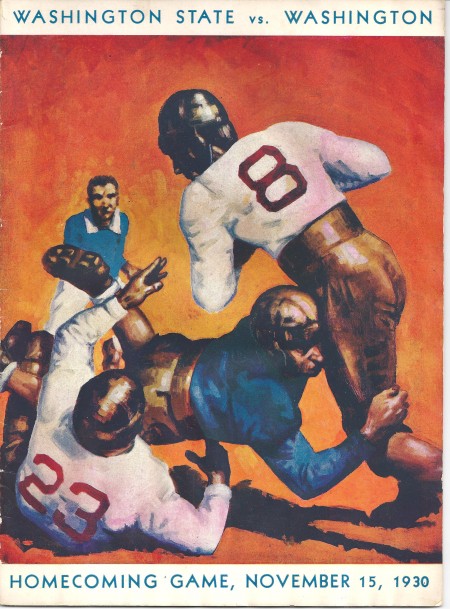
Moon earned the MVP award after scoring the game-winning TD. Brunell threw a 17-yard TD pass to Andre Rison and Bledsoe tossed a 14-yard TD pass to Jimmy Smith.
Chandler had the misfortune of fumbling the ball over to the AFC late the game, setting up Moon’s one-yard TD run.
UW Pro Bowlers: Moon (9 selections), McElhenny (6), Olin Kreutz (6), Rich Camarillo (5), Weinmeister (4), Lawyer Milloy (4), Corey Dillon (4), Ben Davidson (3), Kevin Gogan (3), Brunell (3), Chuck Allen (2), Chandler (2).
WSU Pro Bowlers: Keith Lincoln (5), Bledsoe (4), Gail Cogdill (3), Rypien (2), Rueben Mayes (2), Jason Hanson (2), Keith Millard (2).
Five In Canton: Five who participated in the UW-WSU rivalry are in the Pro Football Hall of Fame.
Washington’s inductees: McElhenny (1970), Weinmeister (1984) and Moon (2006). Washington State’s inductees: Hein (1963) and Edwards (1969).
APPLE CUP ARCANA
Shut Up: In the early years of the UW-WSU series (1900-09) substitutes were not allowed to talk.
$3,200: Gross gate receipts for the 1910 UW-WSU game at Spokane. A crowd estimated at 2,800 attended the UWs 16-0 victory.
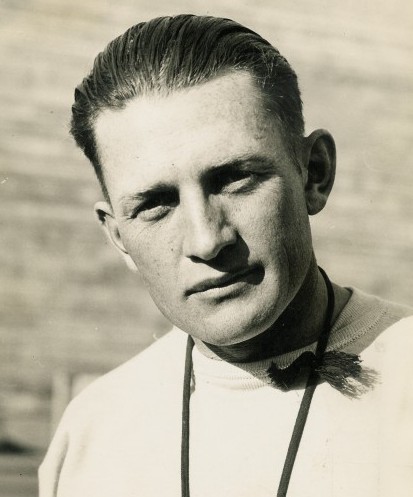
$2, $1, 25 cents: Tickets for the 20th meeting between Washington and Washington State in 1926 went for $2 for a reserved seat, $1 for an unreserved seat, and 25 cents for high school students.
Player To Sports Writer: The captain of the 1928 Huskies, Clarence Dirks, later covered the Huskies for the Seattle Post-Intelligencer.
Red-Faced: After WSU edged Washington 3-0 in 1930, the Cougars traveled to Pasadena to play Alabama in the Rose Bowl.
For the occasion, WSU coach Babe Hollingbery outfitted his team with red helmets, red jerseys, red pants, red socks and red shoes.
The Crimson Tide crushed WSU 24-0, sending the Cougs home red-faced. Washington State did not wear all-crimson uniforms again until the 1982 Apple Cup, when it knocked Washington out of a Rose Bowl trip, 24-20.
“Couskies”: Nine individuals have played for both Washington and Washington State in the Apple Cup. All, except Frank Field at the turn of the 20th century, switched schools during the World War II years when the Navy and Marines transferred students so they could participate in the equivalent of officer candidate training (see Wayback Machine: Pest Welch’s Crazy War Years).
The nine Couskies: Frank Field (1899-00 UW; 1897 WSU); Al Akins (1943 UW; 1942, 46-47 WSU); Hal Anderson (1946-47 UW; 1942 WSU); Tag Christensen (1943 UW; 1942, 47, WSU); Wally Kramer (UW; 1942, 46; 1943 WSU); Vern Oliver (1943, UW; 1942, WSU); Jay Stoves (1943 UW; 1940-42 WSU); Jim Thompson (1946 UW; 1942 WSU); Bill Ward (1943 UW; 1941-42 WSU).
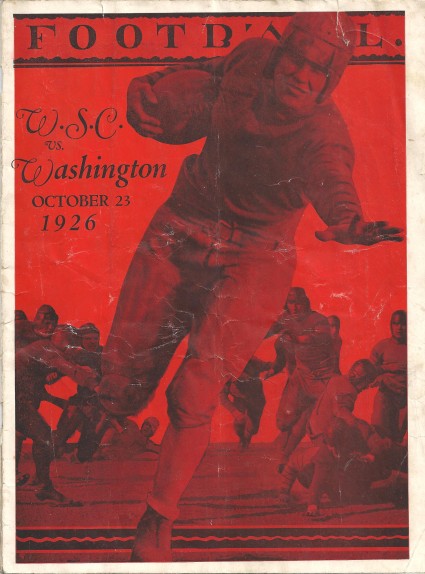
First Apple Cup: The first game in which the Apple Cup trophy was awarded was 1962 (sponsored by the Washington State Apple Commission).
Washington prevailed 26-21 despite Hugh Campbells 178 receiving yards, a WSU record. Prior to that, the winner of the game received the Governors Trophy.
Dual Threat: Defensive back Lawyer Milloy, who played in three Apple Cups (1993-94-95) for Washington, hit a pair of three-run homers against the Cougars in a 1995 UW-WSU “Apple Cup” baseball game.
Venues: The Apple Cup has been played primarily at four venues: Denny Field (1900-1920) and Husky Stadium (1921-2009) in Seattle, and Memorial/Joe Albi Stadium (Spokane) and Martin Stadium (Pullman). It was held in 2011 at CenturyLink Field in Seattle while the Husky Stadium renovation took place.
Martin Stadium is named after Clarence D. Martin, the 11th governor of the state of Washington and a 1906 graduate of the University of Washington.
APPLE CUP CELEBRATIONS / RIOTS
1982: Washington’ s Chuck Nelson missed only one field goal attempt in 26 tries in 1982, but the whiff proved decisive in Washington States 24-20 win over the Huskies at Martin Stadium.
The goal post that eluded Washington’s All-American placekicker was later cut up for souvenirs. One piece was fashioned into a trophy of sorts and remains in WSUs football office.
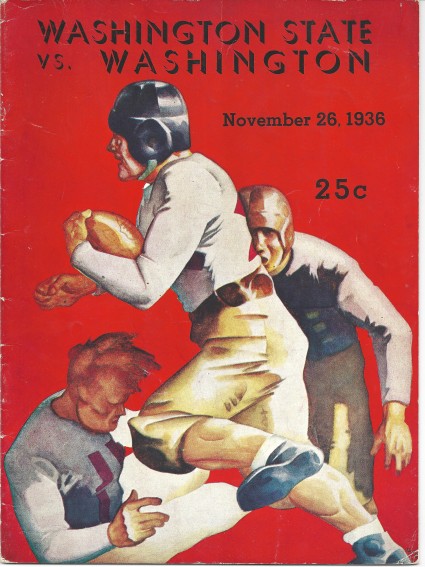
1989: Dozens of UW students tried to tear down the goal posts at Husky Stadium following Washington’s 20-9 victory, and were sprayed with mace by campus police in riot gear.
Two students were arrested and several taken to University Hospital.
1997: When the Cougars defeated the Huskies 41-35 in 1997, it marked the first (and only) time that Washington State qualified for the Rose Bowl by beating Washington at Husky Stadium.
The ensuing WSU celebration on UW turf lasted more than an hour.
(Washington State defeated Washington 3-0 during the 1930 season and played in the 1931 Rose Bowl. The Cougars were invited to the Rose Bowl only after defeating USC the following week).
2000: The season ended in a massive pileup at Martin Stadium, where the Cougars malfunctioned in the Apple Cup, losing 51-3 while establishing several dubious milestones:
Worst loss in Apple Cup history, worst WSU loss in 24 years, worst WSU loss at home in 45 years. The Huskies celebrated a Pac-10 championship and 10-1 season while Washington State moped off with a 4-7 record, 2-6 in conference.
2002: The 95th Apple Cup lasted four hours and nine minutes and three overtimes. After Washington won 29-26, the Huskies charged the field to celebrate. Most of the WSU players quickly departed, but Cougar fans fumed in a foul mood and began tossing bottles lots of bottles on the field.
UW receiver Reggie Williams was hit by a bottle. UW linebacker Greg Carothers’ father was hit by a bottle. So was a Tacoma News Tribune Huskies beat writer, Craig Hill.
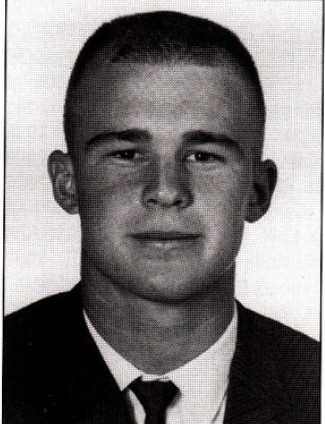
A Seattle television reporter had a cup of beer land on his head while he interviewed UW kicker John Anderson. UW athletic director Barbara Hedges said she “feared for her life.”
2010: Following Washington’s 35-18 win in Pullman, Cougars fans rained water bottles, snowballs and ice chunks on the field, injuring several band members.
As UW defensive tackle Semisi Tokalahi was carted off the field with his broken leg in a cast, WSU fans pelted him with large ice balls.
COACHES
UW Players To Head Coach: Enoch Bagshaw, who earned five football letters playing for Washington from 1903-07, was the first former UW player to become head coach at the school when he began a nine-year run in 1921.
John Cherberg (1930-32) and Jim Lambright (1963-64) are the only other former UW players to become head coaches of the Huskies.
WSU Players To Head Coach: Emory Alvord (1913-14), who coached the Cougars in 1918, Phil Sarboe (1931-33), the head man from 1945-49, and Paul Wulff, are the only former Cougar players to run the football program at WSU (Alvord is almost certainly the only individual to participate in the UW-WSU series who later became a missionary in Rhodesia, now Zimbabwe).
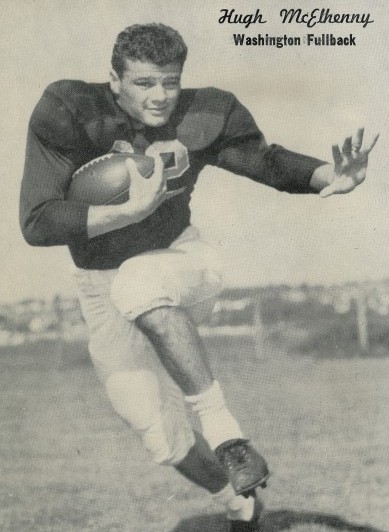
UW-WSU Head Coach To Pro Head Coach: Three who served as head coaches in the UW-WSU series became professional head coaches. Lone Star Dietz, WSUs head coach from 1915-17, coached the Boston Braves in 1933-34.
Dennis Erickson (1987-88) coached the Seattle Seahawks from 1995-98 and the San Francisco 49ers from 2003-04.
Jimmy Phelan, Washington’s coach from 1930-41, coached the Los Angeles Dons in 1948-49 and the Dallas Texans in 1952.
UW Assistant To Pro Head Coach: Jim Mora, an assistant under Don James at Washington from 1976-78, became head coach of the New Orleans Saints and Indianapolis Colts. Mora’s son, Jim Mora Jr. served as a UW graduate assistant in 1984 and later served as head coach of the Atlanta Falcons (2004-06) and Seattle Seahawks (2009).
WSU Players To Pro Head Coach: Four former Cougar players became professional head coaches. Mel Hein (1928-30) coached the Los Angeles Dons in 1957, and Turk Edwards (1929-31) coached the Washington Redskins from 1946-48.
Also, Harland Svare (1950-52) coached the L.A. Rams (1960-62) and San Diego Chargers (1971-73); Hugh Campbell (1960-62) coached the Edmonton Eskimos to five consecutive CFL titles before taking over the Houston Oilers (1984-85).
UW Players To Pro Head Coach: Ex-Husky Don Coryell, a 1949 letterman, coached the St. Louis Cardinals (1973-77) and San Diego Chargers (1978-86). Jim Mora, who played under Don James in the early 1980s, coached the Atlanta Falcons (2004-06) and Seattle Seahawks (2009).
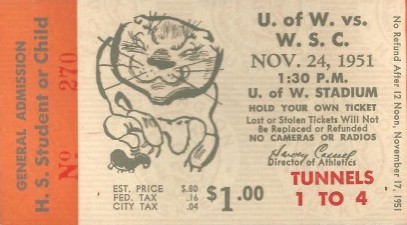
Crossing Over: Two UW assistant coaches became WSU head coaches.
Jim Sutherland, a UW assistant under Johnny Cherberg (1953-55), served as head coach of the Cougars from 1956-63. Bert Clark, an assistant under Jim Owens (1957-74), coached the Cougars from 1964-67.
Neither Sutherland nor Clark produced more than one winning season at WSU. Sutherland compiled a 2-6 record against the Huskies, Clark a 1-3 mark.
Back In The Day, I: Gil Dobie earned $3,000 when he coached the UW in 1908. When he was fired in 1916, after posting a 58-0-3 record, Dobie’s salary had jumped to $3,100 (Dobie won two national championships at Cornell after departing UW).
Back In The Day, II: William Lone Star Dietz coached the Cougars from 1915-17. A Rosebud Sioux, Dietz was an assistant at Carlisle Indian School and a member of its 1911 football team, serving as a blocker for Jim Thorpe.
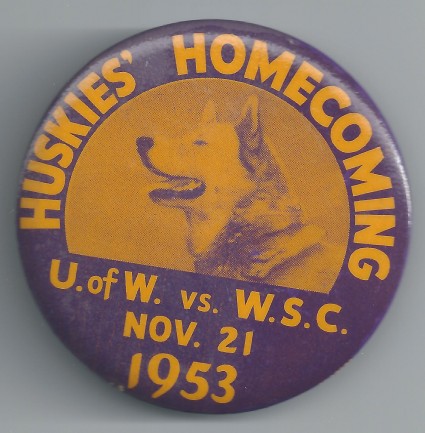
After coaching WSU in its first Rose Bowl (1916), Dietz became an assistant to Pop Warner at Stanford, a consultant to Knute Rockne at Notre Dame and head coach of the Boston Redskins, forerunner of the Washington Redskins.
Dietz’s coaching attire occasionally included a silk top hat, a Prince Albert cutaway coat, striped pants, yellow gloves and a walking stick.
East-West Pioneer: Orin B. Babe Hollingbery, who coached at WSU from 1926 through 1942, initiated the East-West Shrine Game in 1925 and coached in it for many years. His record against Washington: 5-8-4.
APPLE CUP FAMILIES
Fathers & Sons: Carl “Tuffy” Ellingsen’s punting factored greatly in Washington State’s 3-0 victory over Washington in 1930, helping send the Cougars to the 1931 Rose Bowl.
In 1957, Don Ellingsen, Tuffys son, caught eight passes for 82 yards and a TD in WSUs 27-7 victory. UW tackle Mac Bledsoe played in three consecutive Apple Cups (1965-66-67) for the Huskies. His son, Drew, played in three in a row (1990-92) for the Cougars.
Brother vs. Brother: The 1990 Apple Cup matched the first pair of sibling kickers clad in opposing jerseys, Washington State’s Jason Hanson vs. his brother, Husky placekicker Travis.
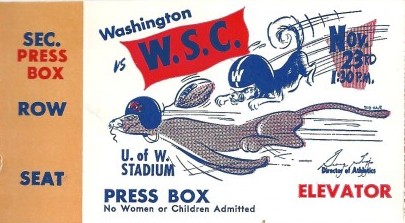
Travis kicked a 42-yard field goal and five extra points in Washington’s 55-10 victory at Martin Stadium. Jason booted a 46-yard field goal and kicked an extra point for the Cougars.
APPLE CUP NUMBERS
Ties: The Huskies and Cougars have played to 0-0 ties three times in their 104 meetings. Two of those occurred two years apart in 1932 and 1934, the last in 1942.
80-Yards Twice: UWs Ernie Steele is the only player in the rivalry to score on two 80-yard plays in the same Apple Cup. He returned a kickoff 87 yards and a punt 83 yards in 1940.
WSU Receivers: Hugh Campbell (178) and Gerald Shaw (106) are the only WSU receivers to exceed 100 yards in the same Apple Cup (1962).
UW Receiver: Reggie Williams is the only Washington receiver to post two 100-yard receiving games in the Apple Cup: 203 yards in 2001 and 169 yards in 2002.
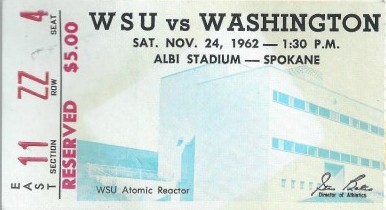
3 x 100: Tim Harris (1980-82) is the only Washington State player with three consecutive 100-yard rushing games against the Huskies (107, 103, 124).
Cougar INTs: Chuck Stone (1953) and Eric Frampton (2006) are the only Cougars to return intercepted passes for TDs against UW.
46 Years Ago: The last time UW entered the Apple Cup with a losing record and WSU had at least six victories was 1965, when the Huskies prevailed 27-9.
43 Years Ago: WSUs 24-0 win in 1968 is the only Cougar shutout in the 49 Apple Cup games contested since 1962.
200 Rushing Yards: Five Huskies and one Cougar have exceeded 200 yards rushing in an Apple Cup game, Hugh McElhenny’s 296 at Joe Albi Stadium in Spokane in 1950 topping the charts. No. 2: Chris Polk’s 284 in Pullman in 2010. Credell Green’s 258 yards in 1955 remains the Husky Stadium single-game record. Denny Fitzpatrick’s 249 yards in 1974 ranks as the No. 1 rushing effort by a UW quarterback.
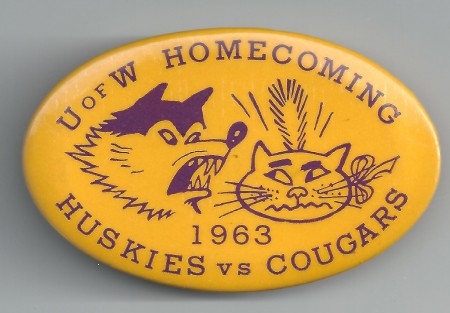
Rashaan Shehee had the other 200-yard game for Washington, a 212-yard effort in 1995. In 2005, Jerome Harrison ran for 207 yards, leading the Cougars to a 26-22 victory.
NFL Passer: If the NFL’s passer rating system were applied to Apple Cup quarterbacks, Ryan Leaf would rank first in the history of the rivalry for a single game.
In 1997, Leaf completed 22 of 38 passes for 358 yards, two touchdowns and one interception. His rating: 104.9. Timm Rosenbach of the Cougars has the No. 2 rating ever, 104.1 in 1988. Washington’s top single-game passer: Brock Huard, 102.8 in 1997.
Pickett’s Charge: Cody Pickett owns the top two passing performances in Apple Cup history. In 2001, he threw for 371 yards and a touchdown in Washingtons 26-14 win. In 2002, Pickett threw for 368 yards and a touchdown in Washington’s 29-26 triple overtime victory.
250+: Drew Bledsoe is one of only two WSU quarterbacks to exceed 250 passing yards three times against the Huskies: 295 in 1990 and 1991 and 259 in 1992.
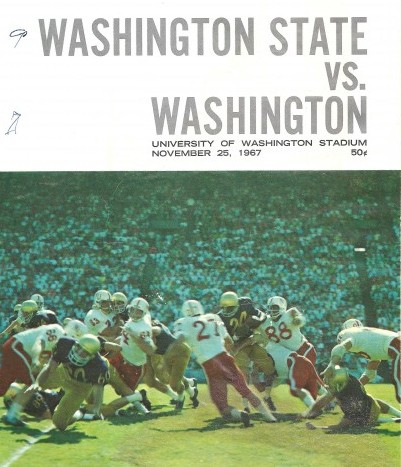
300+: Alex Brink is the only WSU quarterback with two 300-yard passing games against the Huskies.
He had 328 in a 35-32 loss to Washington in 2006 and 399 in a 42-35 win over UW in 2007.
Brink is also the only Washington State quarterback to beat the Huskies three times, 2004, 2005 and 2007.
3 TDs: Only two receivers have scored three TDs in an Apple Cup game.
Mike Levenseller tallied three times for the Cougars in 1976, all on throws from Jack Thompson, and Brian Slater did it for the Huskies in 1986, all on throws from Chris Chandler.
APPLE CUP RIVALRY & RANKINGS
No Games: Washington and Washington State, which first played in 1900, did not meet in 1905, 1906, 1909, 1915, 1916, 1918, 1920, 1943 and 1944.
Two games: In 1945, UW and WSU played two games, the only year they have met twice in one season. The teams split, Washington winning 6-0 and losing 0-7.
Rules Wrinkles: When the teams played to a 5-5 tie in 1900, touchdowns and field goals were worth 5 points. When they played to a tie in 1908, touchdowns were worth five points, field goals worth four points and PATs worth one.
Streak: After losing to WSU in 1907, Washington did not lose another game until 1917. Its 63-game unbeaten streak during that span remains the longest in college football history.
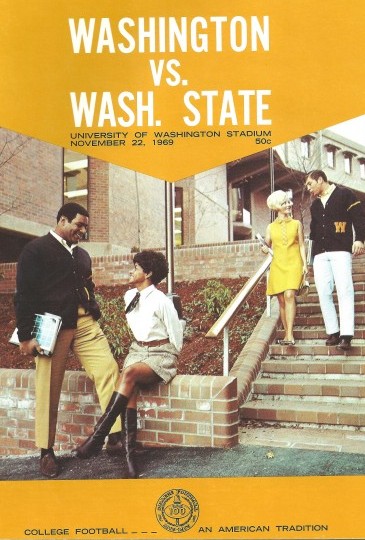
Blankings: The Huskies blanked the Cougars in three consecutive games from 1912-14, winning 19-0, 20-0 and 45-0.
Dominance: Not only did the Cougars beat the Huskies 14-0 in 1917, they held the Huskies to no first downs and no passing yards.
That game also marked the last appearance at WSU for legendary Lone Star Dietz.
Name Changes: 1922 marked the first year the Huskies played the Cougars.
From 1894 through 1919, Washington State went by the Staters, Aggies and Pullman.
WSU students adopted Cougars on Oct. 28, 1919, after a Bay Area sports writer said WSU “played like cougars” in a story detailing WSU’s 14-0 win over California. Originally known as Sun Dodgers, Washington adopted Huskies on Feb. 3, 1922.
Both Ranked: The Associated Press first ranked Washington and Washington State in 1936. The Huskies entered the game at No. 6, the Cougars at No. 20.
Washington won 40-0. Since then, the UW and WSU have both been ranked four times, the last time in 2001 when the Huskies entered the game at No. 16 and the Cougars at No. 9.
Odd Juxtaposition: The 1951 Apple Cup was the only UW-WSU meeting of the 1950s in which the Cougars were ranked (No. 17) and the Huskies were not.
Once In The 70s: UW (No. 17) and WSU (No. 20) were both ranked entering the 1972 Apple Cup, the only time that happened in the 1970s.
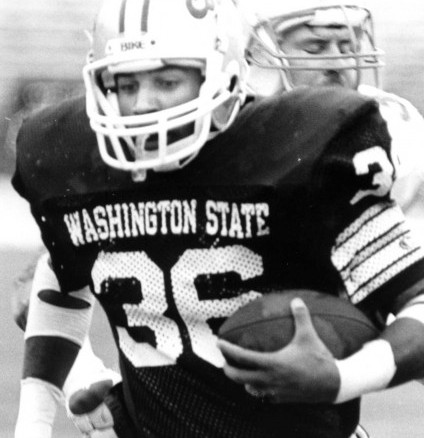
Bad Home Turf: The Cougars won only three of the fifteen Apple Cups played at the Spokane venue (1958, 1968, 1972), first known as Memorial Stadium and then as Joe Albi Stadium.
Glorious ’80s: Washington entered the Apple Cup as a ranked team by The Associated Press in six of the 10 Apple Cups played between 1980-89.
In 1981, Washington and Washington State were ranked, the Huskies at No. 17 and the Cougars at No. 14. Washington won, 23-10.
Rose Bowl Showdown: The 74th renewal of the Apple Cup in 1981 marked the first (and last) time the Pac-10 title and Rose Bowl berth were on the line for both teams. Washington won with Ron Jackson rushing for 103 yards and Jacque Robinson adding 93.
Never Three: The Cougars have never beaten the Huskies three consecutive times.
Best Apple Cups: Based on the combined number of wins by both teams entering the Apple Cup, the 1981, 1992 and 2001 games rank as the best, UW and WSU entering with a combined 17 wins.
Worst Apple Cup: Based on the combined number of losses by both teams entering the Apple Cup, the 2008 game was the worst, UW and WSU entering with a combined 20 defeats.
Rivalry Games: With 104 games in the archives, the Washington-Washington State game is tied for the 14th most-played rivalry in college football history. Top two: Minnesota-Wisconsin (122); Missouri-Kansas (121).
Summary: WSU has not played any rival more often than Washington (104 meetings), but Washington has played Oregon 105 times since 1900.
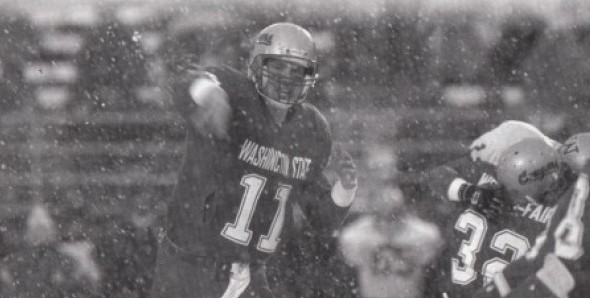
Ranking Histories: Washington has been ranked in The Associated Press preseason poll 28 times and in the final AP poll 22 times. Washington State has been ranked in the AP preseason poll twice and in the final AP poll 11 times.
APPLE CUP ROUTS
Biggest WSU Win / Nov. 24, 1973: The Cougars raced to a 42-6 lead at the half as Andrew Jones, who finished with 139 rushing yards, scored on runs of 12, 1 and 62 yards. Not even four TD passes by Washington’s Chris Rowland could rescue the Huskies, who finished with a 2-9 record, including an 0-7 mark in conference play.
Chuck Peck, the WSU quarterback, completed nine of 17 passes for 249 yards and two touchdowns.
Biggest UW Win / Nov. 18, 2000: Marques Tuiasosopo threw three TD passes, Rich Alexis (134) and Braxton Cleman (105) both surpassed 100 yards rushing and Washington amassed 526 yards in routing the Cougars in Pullman.
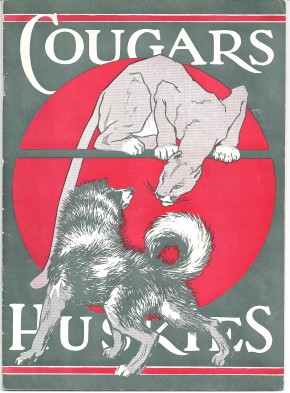
In becoming the first UW quarterback since Sonny Sixkiller in 1970-71 to throw for more than 2,000 yards in consecutive seasons, Tuiasosopo completed 11 of 20 passes and had TD throws of 34 and 6 yards to Justin Robbins and 19 yards to Wilbur Hooks.
UW held the Cougars to just 210 yards and prevented WSU from scoring a TD for the first time in 69 games.
TEAMMATES
Husky/Cougar Touchdown Plays: Touchdown pass plays involving ex-UW or ex-WSU quarterbacks and ex-UW or ex-WSU receivers in the NFL: Nov. 30, 1997: Moon (UW) 20-yard TD pass to Steve Broussard (WSU) for the Seahawks vs. the Falcons; Sept. 11, 2000: Bledsoe (WSU) 6-yard TD pass to Eric Bjornsen (UW) for the Patriots vs. the Jets; Oct. 8, 2000: Bledsoe (WSU) 2-yard pass to Bjornsen (UW) for the Patriots vs. the Colts.
—————————————————–
Many of the historic images published on Sportspress Northwest are provided by resident Northwest sports history aficionado David Eskenazi. Check out Davids Wayback Machine Archive. David can be reached at (206) 441-1900, or at seattlesportshistory@gmail.com
